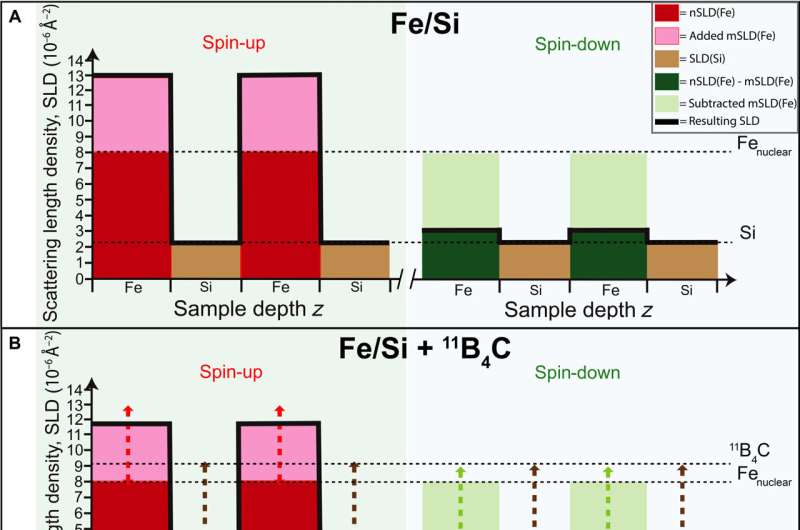This article has been reviewed according to Science X's editorial process and policies. Editors have highlighted the following attributes while ensuring the content's credibility:
fact-checked
trusted source
proofread
Better neutron mirrors can reveal the inner secrets of matter

Improved neutron mirrors can increase the efficiency of material analysis in neutron sources such as the European Spallation Source. The improved mirror has been developed by researchers at Linköping University by coating a silicon plate with extremely thin layers of iron and silicon mixed with boron carbide. Their study has been published in the journal Science Advances.
"Instead of increasing the power on the neutron source, which is extremely expensive, it's better to focus on improving optics," says Fredrik Eriksson, researcher at the Thin Film Physics Division at Linköping University.
Together with protons, neutrons form atomic nuclei. Depending on the number of neutrons in a nucleus, the properties of the element can differ. In addition, neutrons can also be used to analyze different materials at a very detailed level. This method is called neutron scattering.
Such measurements are carried out at special neutron research laboratories called neutron sources. One such laboratory, the European Spallation Source, or ESS, is now being built outside Lund. This is an investment of EUR 2 billion.
The ESS and other neutron sources can be compared to advanced microscopes that allow scientists to investigate various materials and their properties down to the atomic level. They are used in everything from studying atomic structures, material dynamics and magnetism, to the functions of proteins.
It requires enormous amounts of energy for the neutrons to be released from the atomic nuclei. When the neutrons are released in the neutron source, they must be captured and directed toward their target, that is, the material to be investigated. Special mirrors are used to direct and polarize the neutrons. These are known as neutron optics.
Although the ESS will have the world's most powerful neutron source, the number of neutrons available in the experiments will be limited. To increase the number of neutrons that reach the instruments, improved polarizing optics are required. This is something researchers from Linköping University have now achieved by improving neutron optics on several important points to increase efficiency.
"Our mirrors have better reflectance, which increases the number of neutrons that reach their target. The mirror can also polarize the neutrons into the same spin much better, which is important for polarized experiments," says Anton Zubayer, doctoral student at the Department of Physics, Chemistry and Biology and lead author of the Science Advances article.
He continues, "Also, as this no longer requires a large magnet, the mirror can be placed closer to the samples or other sensitive equipment without affecting the samples themselves, which in turn enables new types of experiments. In addition, we have also reduced the diffuse scattering, which means that we can reduce background noise in the measurements."
The mirrors are manufactured on a silicon substrate. Through a process called magnetron sputtering, it is possible to coat the substrate with selected elements. This process makes it possible to coat it with several thin films on top of each other, i.e. a multilayer film.
In this case, iron and silicon films are used, mixed with isotopic enriched boron carbide. If the layer thicknesses are of the same order of magnitude as the neutron wavelength, and the interface between the layers is very smooth, the neutrons can exit the mirror in phase with each other, giving a high reflectivity.
Fredrik Eriksson believes that every neutron is precious and every small improvement in the efficiency of the neutron optics is valuable to improve the experiments.
"By increasing the number of neutrons and also reflecting higher neutron energies, opportunities are opened for pioneering experiments and groundbreaking discoveries across disciplines including physics, chemistry, biology and medicine," says Fredrik Eriksson.
Neutron analysis makes use of the neutrons' ability to behave both as a wave and as a particle. These neutrons, in turn, can have two different spins. It is important mainly for magnetic studies to be able to use polarized neutrons, i.e. neutrons with only one specific spin.
More information: Anton Zubayer et al, Reflective, polarizing, and magnetically soft amorphous neutron optics with 11 B-enriched B 4 C, Science Advances (2024). DOI: 10.1126/sciadv.adl0402
Provided by Linköping University





















